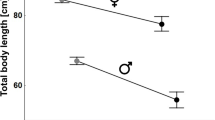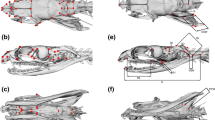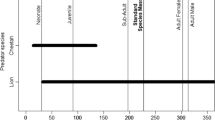Abstract
A predator’s body size correlates with its prey size. Change in the diet may call for changes in the hunting mode and traits determining hunting success. We explored long-term trends in sternum size and shape in the northern goshawk by applying geometric morphometrics. Tetraonids, the primary prey of the goshawk, have decreased and been replaced by smaller birds in the diet. We expected that the size of the goshawk has decreased accordingly more in males than females based on earlier observations of outer morphology. We also expected changes in sternum shape as a function of changes in hunting mode. Size of both sexes has decreased during the preceding decades (1962−2008), seemingly reflecting a shift in prey size and hunting mode. Female goshawks hunting also mammalian prey tend to have a pronouncedly “Buteo-type” sternum compared to males preying upon birds. Interestingly, the shrinkage of body size resulted in an increasingly “Buteo-type” sternum in both sexes. In addition, the sternum shape in birds that died accidentally (i.e., fit individuals) was more Buteo-type than in starved ones, hinting that selection was towards a Buteo-type sternum shape. We conclude that these observed patterns are likely due to directional selection driven by changes in the diet towards smaller and more agile prey. On the other hand, global warming is predicted to also cause a decrease in size, thus these two scenarios are inseparable. Because of difficulties in studying fitness-related phenotypic changes of large raptors in the field, time series of museum exemplars collected over a wide geographical area may give answers to this conundrum.





Similar content being viewed by others
References
Abrams PA (2000) The evolution of predator-prey interactions: theory and evidence. Annu Rev Ecol Syst 31:79–105
Alerstam T, Rosen M, Bäckman J, Ericson PG, Hellgren O (2007) Flight speeds among bird species: allometric and phylogenetic effects. PLoS Biol 5:1656–1662
Barton K (2013) MuMIn: multi-model inference R package version 195. http://www.CRANR-projectorg/package=MuMIn
Barton NWH, Houston DC (1994) Morphological adaptation of the digestive tract in relation to feeding ecology of raptors. J Zool 232:133–150
Baumel JJ, Witmer LM (1993) Osteologia. In: Baumel JJ, King AS, Breazile JE, Evans HE, Vanden Berge JC (eds) Handbook of avian anatomy: nomina anatomica avium. Nuttall Ornithol Club 23:45−132
Blackburn TM, Gaston KJ, Loder N (1999) Geographic gradients in body size: a clarification of Bergmann’s rule. Divers Distrib 5:165–174
Burnham KP, Anderson DR (2002) Model selection and multi-model inference: a practical information-theoretic approach. Springer, New York
Corvidae EL, Bierregaard RO, Peters SE (2006) Comparison of wing morphologies in there birds of prey: correlations with differences in flight behavior. J Morphol 267:612–622
Cramp S, Simmons KEL (eds) (1980) Handbook of the birds of Europe, the Middle East and North Africa. The birds of the Western Palearctic. 2. Hawks to bustards. Oxford University Press, Oxford
Dietz WM, Piersma T, Hedenström M, Brugge M (2007) Intraspecific variation in avian pectoral muscle mass: constraints on maintaining maneuverability with increasing body mass. Funct Ecol 21:317–326
Düzler A, Özgel Ö, Dursun N (2006) Morphometric analysis of the sternum in avian species. Turk J Vet Anim Sci 30:311–314
Grant PR, Grant R (2002) Unpredictable evolution in a 30-year study of Darwin’s finches. Science 296:707–711
Hakkarainen H, Korpimäki E (1995) Contrasting phenotypic correlations in food provision of male Tengmalm’s owls (Aegolius funereus) in a temporally heterogenous environment. Evol Ecol 9:30–37
Helle P (1985) Effects of forest regeneration on the structure of bird communities in northern Finland. Ecography 8:120–132
Jaksic FM, Carothers JH (1985) Ecological, morphological, and bioenergetics correlates of hunting mode in hawks and owls. Ornis Scand 16:165–172
Jenkins AR (1995) Morphometrics and flight performance of southern African peregrine and Lanner falcons. J Avian Biol 26:49–58
Kenward RE, Marcström V, Karlbom M (1981) Goshawk winter ecology in Swedish winter habitats. J Wildl Manage 4:397–408
Kurki S, Nikula A, Helle P, Linden H (2000) Landscape fragmentation and forest composition effects on grouse breeding success in boreal forests. Ecology 81:1985–1997
Lehikoinen A, Lindén A, Byholm P, Ranta E, Saurola P, Valkama J, Kaitala V, Lindén H (2013) Impact of climate change and prey abundance of a top predator, the goshawk. Oecologia 171:283–293
Ludwig GX, Alatalo RV, Helle P, Lindén H, Lindström J, Siitari H (2006) Short- and long-term population dynamical consequences of asymmetric climate change in black grouse. Proc R Soc B 273:2009–2016
Lundevall C-F (1979) Våra fåglar. Almqvist and Wiksell, Stockholm
Marcström V, Kenward R (1981) Sexual and seasonal variation in condition and survival of Swedish goshawks Accipiter gentilis. Ibis 123:311–327
Massemin S, Korpimäki E, Wiehn J (2000) Reversed sexual size dimorphism in raptors: evaluation of the hypotheses in kestrels breeding in a temporally changing environment. Oecologia 124:26–32
Millien V, Lyons SK, Olson L, Smith FA, Wilson AB, Yom-Tov Y (2006) Ecotypic variation in context of global climate change: revisiting the rules. Ecol Lett 9:853–869
Møller AP, Solonen E, Byholm PT, Huhta E, Nielsen JT, Tornberg R (2012) Spatial consistency in susceptibility of prey species to predation by two accipiter hawks. J Avian Biol 43:390–396
Norberg UM (1990) Vertebrate flight. Springer, Berlin
Pennycuick CJ, Fuller MR, Oar JJ, Kirkpatrick SJ (1994) Falcon versus grouse: flight adaptations of a predator and its prey. J Avian Biol 25:39–49
Penteriani V, Rutz C, Kenward R (2013) Hunting behaviour and breeding performance of northern goshawks Accipiter gentilis in relation to resource availability, sex, age and morphology. Naturwissenschaften 100:935–942
Piersma Theunis, Dietz Maurine W (2007) Twofold seasonal variation in the supposedly constant, species-specific, ratio of upstroke to downstroke flight muscles in red knots Calidris canutus. J Avian Biol 38(5):536–540
Poore SO, Sánchez-Haiman A, Goslow GE Jr (1997) Wing upstroke and the evolution of flapping flight. Nature 387:799–802
R Core Team (2012) R: a language and environment for statistical computing. Version 2151. R Foundation for Statistical Computing, Vienna. http://www.r-projectorg/
Rayner JMV (1988) Form and function in avian flight. In: Johnston RF (ed) Current ornithology, vol. 5, Plenum, New York, pp 1−66
Rohlf FJ (2008) tpsRelw: relative warps 146. Department of Evolution and Ecology, State University of New York, Stony Brook
Rohlf FJ (2009a) tpsDig 214. Department of Evolution and Ecology, State University of New York, Stony Brook
Rohlf FJ (2009b) tpsUtil: tps utility program 144. Department of Evolution and Ecology, State University of New York, Stony Brook
Ruosteenoja K, Räisänen J, Pirinen P (2011) Projected changes in thermal seasons and the growing season in Finland. Int J Climatol 31:1473–1487
Schmiegelow FKA, Mönkkönen M (2002) Habitat loss and fragmentation in dynamic landscapes: avian perspectives from the boreal forest. Ecol Appl 12:375–389
Sergio F, Blas J, Baos R, Forero MG, Donázar JA, Hiraldo F (2009) Short-and long-term consequences of individual and territory quality in a long-lived bird. Oecologia 160:507–514
Sulkava S, Huhtala K, Rajala P, Tornberg R (1999) Changes in the diet of the golden eagle (Aquila chrysaetos) and small game populations in Finland in 1957−96. Ornis Fenn 76:1–16
Sulkava S, Linkola P, Lokki H (2006) Diet of the goshawk during breeding season in Häme (in Finnish with English summary). Suomen Riista 52:85–96
Sunde P (2002) Starvation mortality and body condition of goshawks Accipiter gentilis along a latitudinal gradient in Norway. Ibis 144:301–310
Tornberg R (1997) Prey selection of the goshawk Accipiter gentilis during the breeding season: the role of prey profitability and vulnerability. Ornis Fenn 74:15–28
Tornberg R, Colpaert A (2001) Survival, ranging, habitat choice and diet of the northern goshawk (Accipiter gentilis) during winter in Northern Finland. Ibis 143:41–50
Tornberg R, Sulkava S (1991) The effect of changing tetraonid populations on the nutrition and breeding success of the goshawk (Accipiter gentilis L.) in Northern Finland. Aquil Ser Zool 28:23–33
Tornberg R, Mönkkönen M, Pahkala M (1999) Changes in diet and morphology of Finnish goshawks from 1960s to 1990s. Oecologia 121:369–376
Tornberg R, Korpimäki E, Byholm P (2006) Ecology of the Northern goshawk in Fennoscandia. Stud Avian Biol 31:141–157
Tornberg R, Mönkkönen M, Kivelä S (2009) Short communication: landscape and season effects on the diet of the goshawk. Ibis 151:396–400
Yom-Tov Y, Yom-Tov S (2006) Decrease in body size of Danish goshawks during the twentieth century. J Ornithol 147:644–647
Yom-Tov Y, Yom-Tov S, Baagøe H (2003) Increase of skull in the red fox Vulpes vulpes and Eurasian badger Meles meles in Denmark during the twentieth century: an effect of improved diet? Evol Ecol Res 5:1037–1048
Yom-Tov Y, Yom-Tov S, Wright J, Thorne CJR, Du Feu R (2006) Recent changes in body weight and wing length among some British passerine birds. Oikos 112:91–101
Zelditch ML, Swiderski DL, Sheets HD, Fink WL (2004) Geometric morphometrics for biologists: a primer. Elsevier, San Diego
Acknowledgments
We are grateful to the staff of the Zoological Museum of the University of Oulu for their patient collection of bird skeletons. We wish to thank also two anonymous referees for structural comments on the manuscript and Kent Tankersley for correcting the English.
Author information
Authors and Affiliations
Corresponding author
Additional information
Communicated by Chris Whelan.
Electronic supplementary material
Below is the link to the electronic supplementary material.
Rights and permissions
About this article
Cite this article
Tornberg, R., Liuska, L., Rytkönen, S. et al. Diet shift induced rapid evolution of size and function in a predatory bird. Oecologia 176, 781–788 (2014). https://doi.org/10.1007/s00442-014-3044-1
Received:
Accepted:
Published:
Issue Date:
DOI: https://doi.org/10.1007/s00442-014-3044-1




